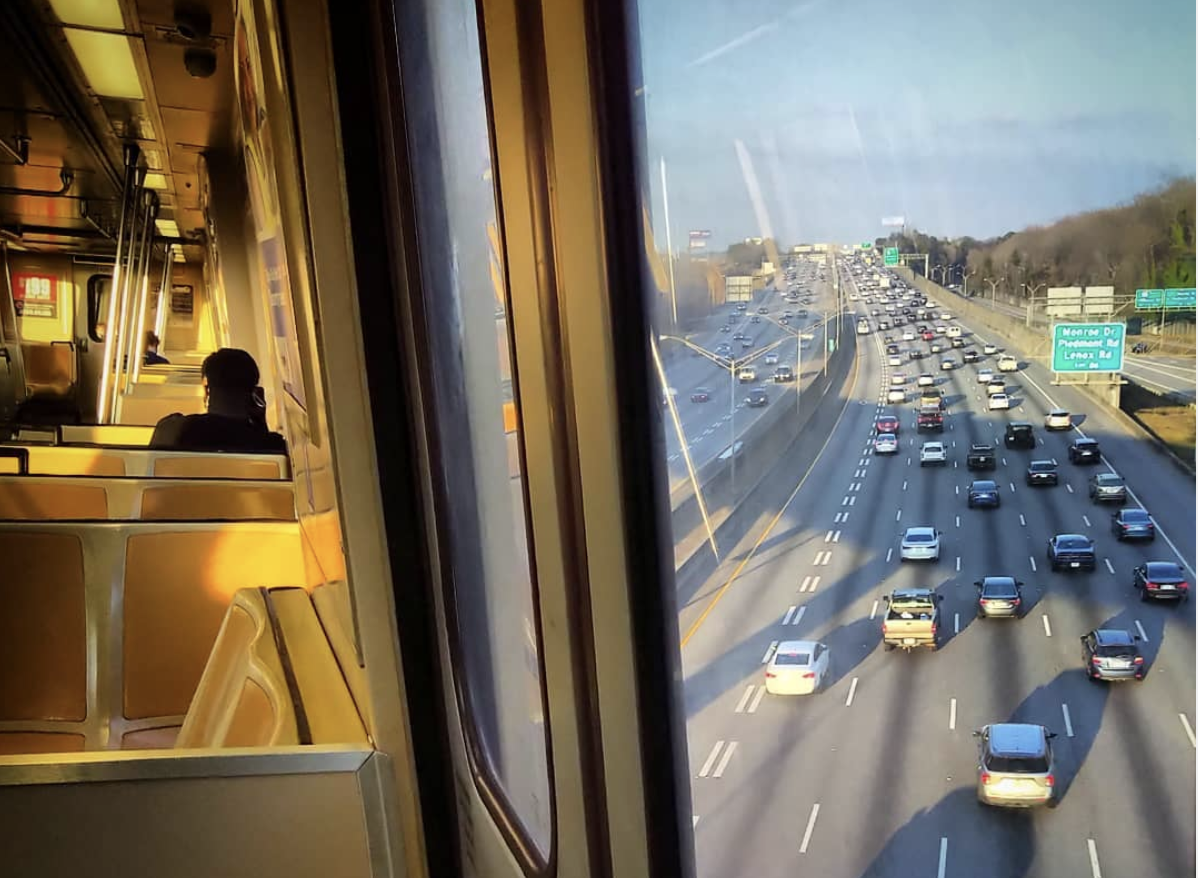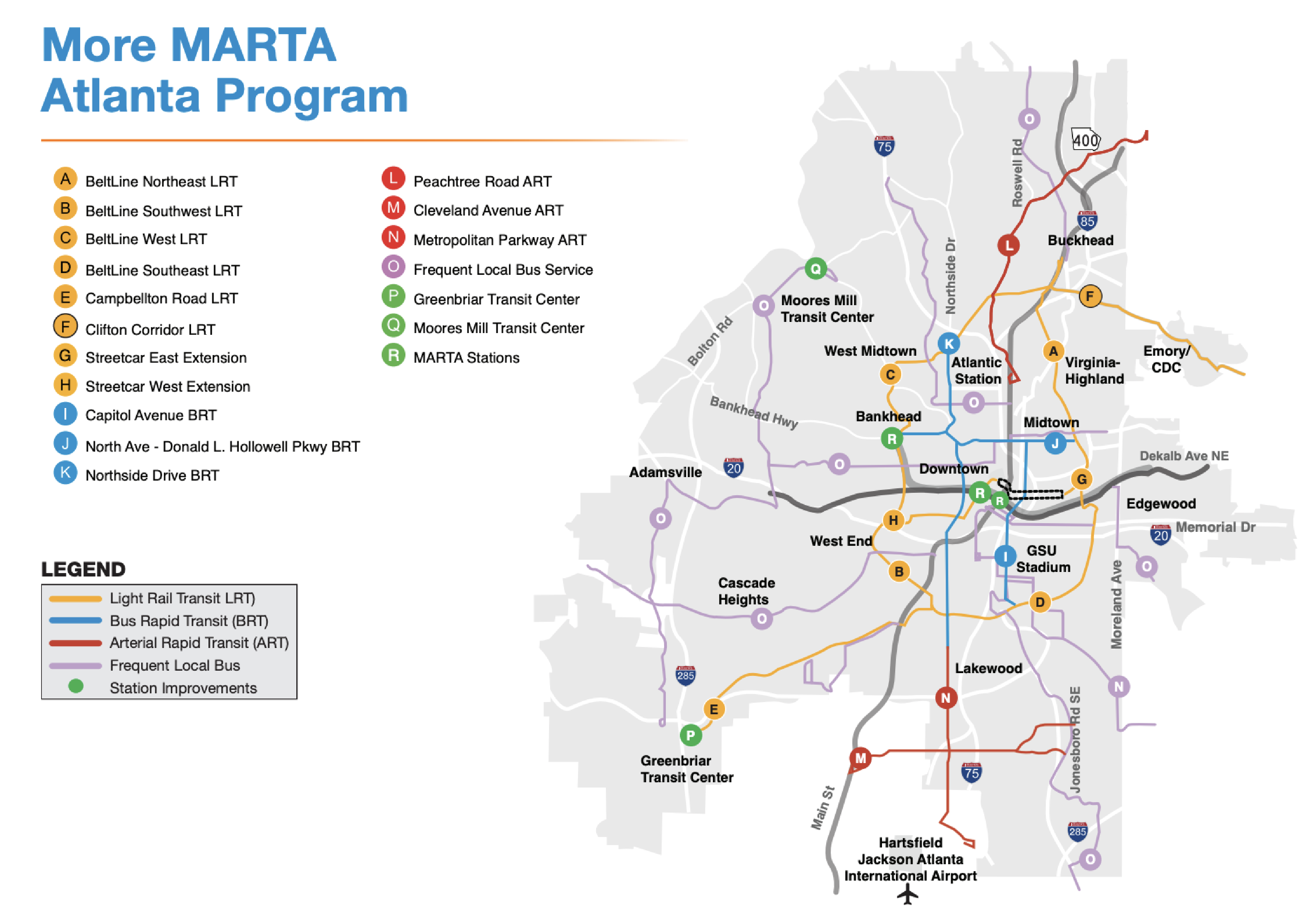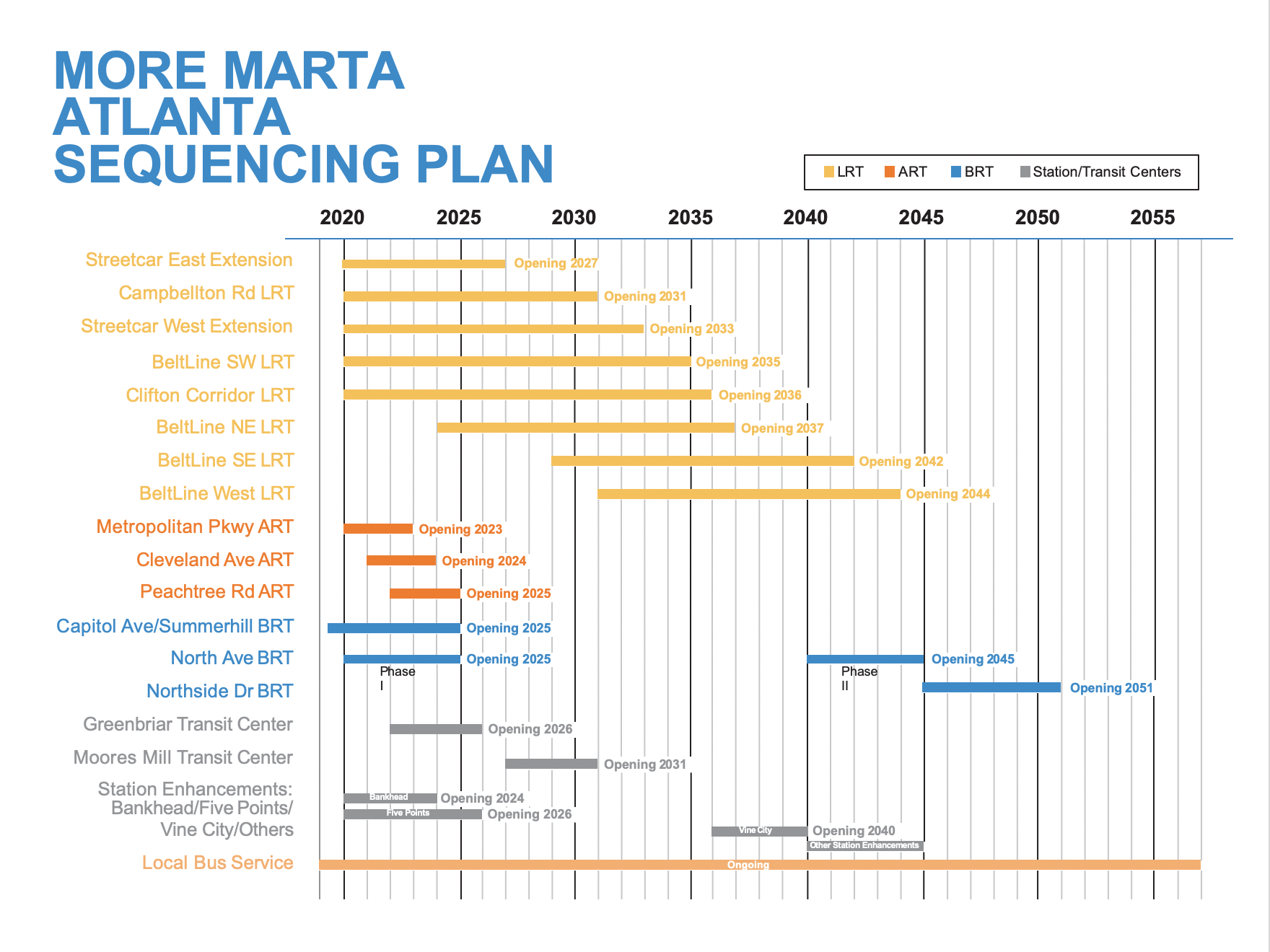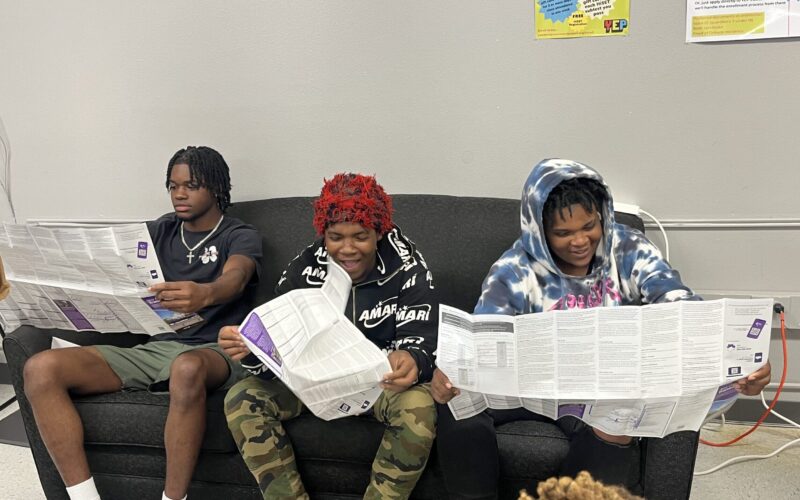
Photo via Marta Explorers
Atlanta is one of the fastest growing urban regions in the country, projected to gain 2.5 million residents by 2040. But the city’s transit system, consisting of two rail spines, a mixed-traffic streetcar, and a bus network without many all-day frequent routes, is comparatively small. Atlanta has one of the lowest per capita transit ridership rates among big cities in the country, and ridership had been on a steady decline prior to the COVID-19 pandemic.
Atlanta residents are eager for more transit options. In 2016, they voted by a nearly 3-1 margin to approve More MARTA, a half-cent sales tax within the city of Atlanta that currently generates about $75 million each year for transit. Four years later, what improvements are now tangible for Atlanta transit riders, and what can riders expect to see in the next four?
In brief, the main upgrades so far are related to system upkeep and reliability. Major rail expansions are a decade or more away. MARTA’s upcoming bus network redesign is a promising way to generate significant service improvements in the near future, but so far the agency doesn’t plan to increase the budget for bus operations as part of the initiative.
According to Bakari Height, co-founder of the grassroots action group MARTA Army, things haven’t changed dramatically for the average rider since 2016. “As far as the More MARTA plan goes, there hasn’t really been much that we can actually see.” Although MARTA boosted bus service frequency after the referendum in 2017, many of the routes have since been cut as a result of the pandemic.
Most of the work over the past four years has been happening behind the scenes, said Heather Alhadeff, assistant general manager of planning at MARTA. “There’s a lot of repair that needs to happen with a 40-year-old system,” she said. “Much of this work isn’t visible to the public, but we’re making significant progress.”
The agency has recently made $200 million in rail improvements, including rehabbing escalators and elevators, upgrading stations and train control systems, and procuring new rolling stock. MARTA has also spent $20 million on new buses, and has made major investments in upgrading transit center facilities in Clayton and Dekalb Counties, which border the city of Atlanta.
Tejas Kotak, transit chair of the Georgia Sierra Club, believes that MARTA is on an upward trajectory overall. “Things have definitely improved with MARTA. They are physically and financially a lot more stable than they used to be.”
Despite the massive declines in fare revenue wrought by the pandemic, MARTA CEO Jeffrey Parker told Atlanta Magazine in February that federal transit relief funding has put the agency in good financial shape until at least 2024, and that the More MARTA program can proceed as planned.
After the More MARTA vote, MARTA spent two years conducting public engagement, technical analysis, and systemwide planning to determine how to spend the new revenue. The final list of projects approved in 2018 includes 36 miles of enhanced bus routes, and 29 miles of light rail. Kotak said the project list ultimately came down to “what MARTA and the community thought was most feasible in terms of increasing ridership, spending the money well, pulling down federal funds, and a lot of equity and environmental concerns.”

Enhanced communication with riders will be key for the agency as it moves into the planning and construction phase of projects, the majority of which will take decades to complete. If all goes according to schedule, the first major capital investment will be unveiled in 2023 – the Metropolitan Parkway Arterial Rapid Transit, a BRT-lite project which will feature buses that run frequently, with transit signal priority, queue jumps, and enhanced bus stops. This will be followed by the Cleveland Ave and Peachtree ART in 2024, and 2025, respectively.

The city’s first official Bus Rapid Transit project – the Capitol Hill/Summerhill BRT – is slated to open in 2025. The project is only 2.5 miles in length, but will provide a proof of concept for the rest of the BRT projects planned around the city.
The timeline for rail expansion is much longer – the first light rail extension to Campbellton Road, which will serve the SW quadrant of the city, won’t be completed until 2031. Light rail won’t cover the entirety of the city’s circumferential Beltline trail – a long-held dream of many local transit advocates – until 2044.
“So many of the projects have long timelines due to a mix of sales tax funds that come in slowly and the fact that these are expensive projects,” says Kotak. Many of the agency’s longer term-projects, like the Clifton Corridor light rail extension to Emory University, are awaiting additional sources of funding before proceeding to the planning phase.
The most immediate improvements for Atlanta transit Atlantans can potentially look forward to a new bus network as soon as 2022. MARTA recently hired consultant Jarrett Walker to undertake a complete overhaul of the bus system. Though there have been annual changes to the network, the fundamental shape of the system hasn’t changed since the 1970s, says Alhadeff.
MARTA intends the redesign to be budget neutral, meaning it doesn’t plan to add additional bus service as part of the initiative. Given the resources at hand thanks to More MARTA, the slow pace of capital expansion projects, and the imperative to rebuild confidence in the transit system after the pandemic, increasing the budget for bus service in tandem with the network redesign looks like the surest path to give riders significant improvements while the 2016 referendum is still fresh in voters’ minds.
Neither MARTA Army nor Georgia Sierra Club have taken a position on the budget for the network redesign. But Kotak and Height believe that MARTA should take a transformational approach to the redesign, and sever ties with the old network.
“If you ask me personally, MARTA’s too coverage heavy,” said Height. “If you want to make this a better system for everyone, you’re going to have to start from scratch and focus on corridors that provide essential services to current riders.” He says that the agency’s emergency bus network during COVID, designed to serve people who need transit the most, provides a good template for how this can be done.
Kotak emphasizes the need for robust community engagement surrounding the redesign effort. “This is something where it definitely needs a lot of public engagement, a lot of public feedback, and we’re hoping MARTA and Jarrett Walker will pay attention to what the current riders actually want and need.” He says that Georgia Sierra Club is currently brainstorming about the role it can play in the outreach process.
MARTA has also committed to upgrading 1,000 bus shelters within its entire service area over the next five years. Thus far, 92 new shelters have been installed, 100 are in the permitting and design phase, and eight are under construction.
This effort will be key in creating a more comfortable rider experience, says Height. Through its recent “Bus Stop Census,” MARTA Army inventoried at least a third of the stops within the MARTA service area. Height says there’s wide variation in bus stop quality. “Some stops have a shelter, a schedule, lighting, you’re on an expansive sidewalk. And then some stops are laden with kudzu on the road with no shoulder or no sidewalk. So it definitely is a huge inequality with the transit experience, no matter what part of the metro you’re in.”
Kotak agrees that bus stop and sidewalk improvements need to be immediate priorities in the region. “We need sidewalks so that people can safely get onto a bus and then get off a bus and go to destinations as opposed to walking through the mud. That’s something where MARTA doesn’t have the ability to make the change themselves, but they should be more aggressive in asking local governments to do it.”
Height sees MARTA’s focus on major capital expansion as necessary if Atlanta wants to remain competitive with other big cities. But he emphasizes that the agency also needs to focus on improving local bus service. “If we’re going to continue to make these strides with the $2.7 billion that we’re putting into More MARTA, then we have to make the bus a priority, because the bus is most likely going to be one of the connections that riders are going to make within metro Atlanta.” Kotak agrees with this assessment. “Better local bus service will do far more for the Atlanta community than BeltLine Rail could.”
The City of Atlanta’s One Transportation Plan has committed to establishing a network of bus-only lanes and installing upgrades like transit signal priority on city streets by 2022. Height says these improvements can’t come soon enough. “None of these buses have their own lane. None of these buses have signal priority or anything else that would actually enhance their mobility.”
Height says that historically, transit boosters in Atlanta have been too fixated on a hierarchy of transit modes. “We don’t need to look at transit as, ‘Oh, this vehicle needs to be a train.’ We need to look at it as, ‘Okay, this is a service that runs every 15 minutes or less, and this is wonderful for our community.’” He says the bus network redesign is a chance to start thinking holistically about transit service, rather than the type of vehicle.
Kotak thinks that transit advocacy in Atlanta hasn’t always been well coordinated, and getting different factions on the same page will be key to advancing major improvements in the coming years. “I think the various transit advocacy groups in Metro Atlanta need to come together and come up with our major asks for MARTA. We are in conversation right now and we’re still in the nascent stages of forming a more cohesive message, but we’re on the right pathway to that.”
 On the Brink: Will WMATA’s Progress Be Erased by 2024?
On the Brink: Will WMATA’s Progress Be Erased by 2024?
The experience of being a WMATA rider has substantially improved over the last 18 months, thanks to changes the agency has made like adding off-peak service and simplifying fares. Things are about to get even better with the launch of all-door boarding later this fall, overnight bus service on some lines starting in December, and an ambitious plan to redesign the Metrobus network. But all of this could go away by July 1, 2024.
Read More Winning Free Fares for Youth in New Orleans
Winning Free Fares for Youth in New Orleans
Most transit agencies rely on fare revenue to fund operations, meaning many are forced into the position of needing to collect fares from the people who can least afford it. To change this paradigm, advocates across the country are fighting for - and winning - programs that allow agencies to zero out fares for youth, removing one of the largest barriers to youth ridership.
Read More